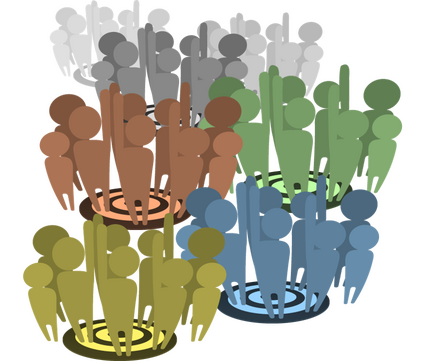Today you hear a lot about personalization in marketing and customization in manufacturing. In this increasingly specialized environment, customer segmentation sounds like a step backwards. After all, customer segmentation can be traced back to the earliest eras of marketing and manufacturing when people intuitively understood that, for the most part, men and women were looking to buy different goods. Despite the lengthy history of segmentation, Muhamed (aka M) Muneer (@Muneermuh), managing director of CustomerLab Solutions, insists, “Customer segmentation helps in delivering relevant and important benefits to customer groups in a consistent manner and will drive competitive advantage.”[1]
On the marketing front, Maxim Koldyshev, marketing director of Guardian Glass, writes, “Target audiences are strategically identified groups of customers who are interested in a particular product or service. They are the foundation on which every business is based. Research and experience show us that ‘blanket’ advertising or marketing doesn’t work: You can’t sell everything to everyone. Without dividing your potential buyers into segmented groups, there is no sales growth.”[2] On the manufacturing front, Muneer views customer segmentation as an important part of today’s movement towards personalization. He writes, “Imagine producing and delivering a one-size-fits-all product to your customers in today’s world when customization is key.”
Customer Segmentation and Why It’s Important
Business journalist Jordan Beier asserts, “Your business serves a wide range of customers with unique interests and needs. One message will not appeal to everyone, but businesses cannot personalize marketing campaigns for each customer. Instead, marketers group their customers into segments. Customer segmentation allows businesses to prioritize and engage with their most important customers through marketing differentiation.”[3] He formally defines customer segmentation this way:
“Customer segmentation is the division of an audience into targeted groups with shared buying characteristics. Each customer segment purchases your product to fulfill the same needs and often communicates through similar channels. The drivers behind a customer purchase shapes product, sales and marketing decisions.”
He adds, “Personalizing your message can have a huge impact on your bottom line, as customers are 75% more likely to buy from businesses that deliver targeted marketing.” John Wanamaker, the late department store magnate, once stated, “Half the money I spend on advertising is wasted. The trouble is I don’t know which half.” I suspect he was wasting more than half of his marketing spend. Koldyshev explains, “Offering goods or services to those who don’t need them is a waste of resources. If you use a broad audience, you’re going by the ‘if you’re lucky’ method.”
Muneer insists, “The choices and alternatives available today for any customer are plenty. Because of these choices in features, substitute products, different price points and so on it is difficult to command loyalty of customers. … If we know the detailed needs of our key customers, we will be in a position to develop and deliver products and services that appeal to them and earn their loyalty. Most marketing books teach us that segmentation is what marketing is all about. Marketing science has no relevance without it.” The essential element to customer segmentation, as Muneer notes, is having detailed information (i.e., data) about key customers.
The Essentials of Customer Segmentation
The above discussion may lead some people to think customer segmentation is easy. It’s not. There are numerous variables that must be considered and myriad ways to segment. As I noted above, the earliest segmentation was probably by gender. Today there are lots of other variables to consider in addition to gender; for example, age, race, religion, and location. Even those broad categories, however, don’t capture all the nuances of your customer data. Koldyshev provides the following list of variables that could (or should) be taken into consideration when segmenting customers (with a focus on B2B customers):
• Industry: niche and place in the market (raw materials, manufacturing, construction, retail, distribution, design, etc.)
• Geography: location and network size (local player, federal network, global, etc.)
• Price policy: low budget, high end/premium, or a mix of the two
• Product performance: product mix and services required to execute
• Business size: number of ongoing projects, sales volume, annual revenue
• Personnel qualification: expertise, experience
• Capabilities: methods of production/processing, automation systems, etc.
• Behavioral parameters: level of urgency and volume of purchase
• Buyer profile: supplier loyalty, risk assessment
• Procurement steps: selection criteria, motivation to purchase
• Purchasing committee: key decision makers
• Beliefs: stereotypes, doubts, objections
• History with company: new, current, or returning customer
• Cooperation with competitors
When focusing on B2C marketing, things can get even more complex. Suggestions for improving customer segmentation — offered by fourteen members of the Forbes Coaches Council — demonstrate why customer segmentation can be complicated.[4] Those suggestions include:
1. Identify pain points.
2. Consider psychographics.
3. Start at the level of entry.
4. Create customer personas.
5. Determine where you’ll derive the most value.
6. Pick a niche.
7. Forecast ahead.
8. Go beyond the data.
9. Review your client portfolio.
10. Create a personalized approach.
11. Think about how valuable your product is to them.
12. Utilize analytics.
13. Use the three-bucket approach (i.e., segment customers into a short-, medium- or long-term time value).
14. Interview your best clients.
After reviewing those lists, one thing should be coming into clear view: marketers need help making sense of all the data necessary to segment customers successfully. That help comes in the form of cognitive technologies. Business analytics expert Mona Eslamijam explains, “Customer segmentation was previously a challenging and time-consuming task that demanded hours of manually poring over different tables and querying the data in hopes of finding ways to group customers together. But in recent years, it has become much easier thanks to machine learning, artificial intelligence algorithms that find statistical regularities in data.”[5] Cognitive technologies, like the Enterra Shopper Marketing and Consumer Insights Intelligence System™, can leverage all types of consumer data to provide high-dimensional consumer, retailer, and marketing insights.
Concluding Thoughts
The Forbes Coaches Council concludes, “As your customer or client base grows, it can be difficult to keep up with each of them on an individual level. Often, it helps to segment your clients with similar needs to maximize interaction efforts and increase retention. This can help you and your team feel more organized and productive when communicating with clients, while ensuring each one has their expectations met.” Just as importantly, segmentation efforts can help companies identify and cater to their most valuable customers. Muneer explains, “Identifying the customer value proposition for each segment is key. This must be with recognizable differentiators and must be unique to each segment. The value proposition must be defendable and demonstrable for sure. Once this is done the next step is planning the value chain and the ways to deliver [value] to your customers.” Koldyshev concludes, “Filtering your audience helps you to reach your goals more quickly. It protects your company’s resources by sifting out nontargeted customers before starting the marketing process. Why try to sell to an audience that is misled by advertising and ends up buying nothing? ‘Carpet-bombing’ your audience is an out-of-date strategy. Today, companies should focus on specific segments, in the process building their reputation and engendering long-term cooperation.”
Footnotes
[1] Muhamed Muneer, “Why segmenting your customers right is imperative for sustained growth,” Money Control, 22 May 2021.
[2] Maxim Koldyshev, “Target-Audience Segmentation: Why You Need It and How to Do It in Five Easy Steps,” MarketingProfs, 8 October 2020.
[3] Jordan Beier, “What Is Customer Segmentation?” Business News Daily, 22 January 2021.
[4] Forbes Coaches Council, “14 Effective Ways To Segment Customers,” Forbes, 12 August 2020.
[5] Mona Eslamijam, “Customer segmentation: How machine learning makes marketing smart,” TechTalks, 28 December 2020.





